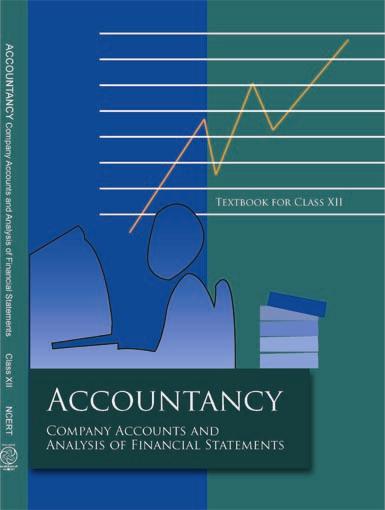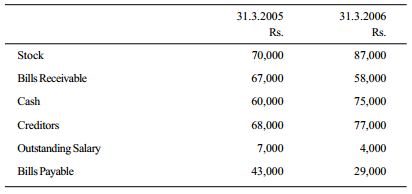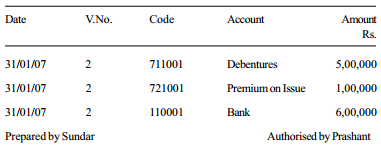
myCBSEguide App
Download the app to get CBSE Sample Papers 2023-24, NCERT Solutions (Revised), Most Important Questions, Previous Year Question Bank, Mock Tests, and Detailed Notes.
Install NowCBSE Question Paper 2007 class 12 Accountancy conducted by Central Board of Secondary Education, New Delhi in the month of March 2007. CBSE previous year question papers with solution are available in myCBSEguide mobile app and cbse guide website. The Best CBSE App for students and teachers is myCBSEguide which provides complete study material and practice papers to cbse schools in India and abroad.
CBSE Question Paper 2007 class 12 Accountancy
Class 12 Accountancy list of chapters
Accountancy Part I
- Accounting for Not-for-Profit Organisation
- Accounting for Partnership: Basic Concepts
- Reconstitution of a Partnership Firm – Admission of a Partner
- Reconstitution of Partnership Firm – Retirement/Death of a Partner
- Dissolution of Partnership Firm
Accountancy Part II
- Accounting for Share Capital
- Issue and Redemption of Debentures
- Financial Statements of a Company
- Analysis of Financial Statements
- Accounting Ratios
- Cash Flow Statement
CBSE Question Paper 2007 class 12 Accountancy
General Instructions:
(i) This question paper contains three parts A, B and C.
(ii) Part A is compulsory for all candidates.
(iii) Candidates can attempt only one part of the remaining parts B and C.
(iv) All parts of the questions should be attempted at one place.
Part ‘A’
1. List any four items which can be credited to the Capital Account of a partner when the Capital Account is fluctuating. (2)
2. State the conditions according to Sec. 79 of Company Act 1956 for the issue of shares at discount. (2)
3. What is meant by ‘Preferential Allotment of Shares’? (2)
4. Give the meaning of a Debenture. (2)
5. Ram and Shyam were partners in a firm sharing profits in the ratio of 3 : 5. Their Fixed Capitals were: Ram Rs. 5,00,000 and Shyam Rs. 9,00,000. After the accounts of the year had been closed, it was found that interest on capital at 10% per annum as provided in the partnership agreement has not been credited to the Capital Accounts of the partners. Pass a necessary entry to rectify the error. (3)
6. AB Ltd. issued 5,00,000, 7% debentures of Rs. 50 each. Pass necessary journal entries in the books of the company for the issue of debentures when debentures were: (3)
(i) Issued at par, redeemable at 8% premium,
(ii) Issued at 4% premium redeemable at 5% premium,
(iii) Issued at 5% premium redeemable at par.
7. Hari, Ravi and Kavi were partners in a firm sharing profits in the ratio of 3 : 2 : 1. They admitted Guru as a new partner for l/7th share in the profits. The new profit sharing ratio will be 2 : 2 : 2 : 1 respectively. Guru brought Rs. 3,00,000 for his capital and Rs. 45,000 for his l/7th share of goodwill. Showing your working clearly, pass necessary journal entries in the books of the firm for the above-mentioned transactions. (4)
8. Chander and Naresh were partners in a firm sharing profits in 3 :2 ratio. On 28.2.2007 their firm was dissolved. After the transfer of various assets (other than cash) and third-party liabilities to Realisation Account, the following transactions took place:
(i) An unrecorded asset costing Rs. 9,000 was taken over by Chander for Rs. 7,800.
(ii) Creditors Rs. 47,500 were paid Rs. 45,000 in full settlement of their claim,
(iii) Expenses of realisation Rs. 1,200 were paid by Naresh.
(iv) Loss on dissolution was Rs. 3,400.
Pass necessary journal entries for the above transactions in the books of the firm. (4)
9. Poonam Ltd. had a balance of Rs. 55,00,000 in its Profit and Loss account. Instead of declaring a dividend it decided to redeem its Rs. 50,00,000, 8% debentures at a premium of 10%. Pass necessary journal entries in the books of the company for the redemption of debentures. (4)
10. On 1st August 2006 K.M. Ltd. buys, 10,000, 9% debentures of Rs. 100 at Rs. 95 each cum interest, the dates of interest being March 31 and September 30. Record necessary journal entries when debentures are purchased for cancellation. Show your working also. (4)
11. J.P. Ltd. purchased building costing Rs. 70,00,000 from M/s Construction Ltd. The company paid Rs. 20,50,000 by cheque and for the balance issued equity shares of Rs. 100 each in favour of M/s Constructions Ltd. Pass necessary journal entries in the books of J.P. Ltd. for the purchase of building and making payment if shares were issued (a) at 10% discount and (b) at a premium of 25%. (4)
12. Samta and Mamta were partners in a firm sharing profits in the ratio of 3 :1. On 1.3.2006 the firm was dissolved. On that date the Balance Sheet of the firm was as follows:
Balance Sheet of Samta and Mamta as on 1.3. 2006
| Liabilities | Amount Rs. | Assets | Amount rs. |
| Loan Creditors Capitals: Samta 3,00,000 Mamta 1,10,000 | 70,000 1,30,000
4,10,000 6,10,000 | Cash Building Stock Profit & Loss Accounts | 20,000 5,00,000 30,000 60,000 6,10,000 |
Building realised Rs. 6,50,000 and stocks Rs. 12,000. Rs. 1,29,000 were paid to the creditors in full settlement of their claim. The firm had a joint life policy of Rs. 5,00,000 which was surrendered for Rs. 1,27,000. The annual premium paid on the joint life policy was debited to the Profit and Loss account. Prepare Realisation Account, Cash Account and Partners Capital Accounts. (6)
OR
Sameer and Sudhir were partners in a firm sharing profits in the ratio of 5 : 3. On 28.2.2007 the firm was dissolved. On the date of dissolution Sameer’s capital was Rs. 2,40,000 and Sudhir’s capital was Rs. 1,80,000. Creditors on that date were Rs. 80,000 and there was a balance of Rs. 1,36,000 in general reserve A/C. Cash balance was Rs. 20,000. Sundry assets realised Rs. 7,50,000 and expenses on dissolution were Rs. 2,000 which were paid by Sudhir.
Prepare Realisation Account, Cash Account and Partners Capital Accounts. (6)
13. Shakti Ltd. invited applications for issuing 2,00,000 equity shares of Rs. 100 each at a premium of Rs. 10 per share. The amount was payable as follows:
On application Rs. 40 per share (including premium) on allotment Rs. 30 per share and the balance on first and final call. Applications for 3,00,000 shares were received. Applications for 40,000 shares were rejected and pro-rata allotment was made to the remaining applicants. Over payments on applications were adjusted towards sums due on allotment. Manoj who was allotted 2,000 shares failed to pay the allotment and first and final call money. His shares were forfeited. The forfeited shares were re-issued at Rs. 90 per share fully paid up. Pass necessary journal entries in the books of Shakti Ltd. showing the working clearly. (6)
OR
Pass necessary journal entries in the books of Raman Ltd. for the following transactions:
(i) 400 equity shares of Rs. 100 each issued at a discount of 10% were forfeited for the non-payment of final call of Rs. 20 per share. The forfeited shares were re-issued for Rs. 38,000 fully paid up.
(ii) 300 equity shares of Rs. 100 each were forfeited for the non-payment of the allotment money of Rs. 40 per share. The first and final call of Rs. 20 per share was not made. The forfeited shares were re-issued for Rs. 29,000 fully paid up.
14. G, H and I were partners of a firm sharing profit in the ratio of 4:3 :3. On 31.3.2006 their Balance Sheet was as follows:
Balance Sheet of G, H and I as on 31.3.2006
| Liabilities | Amount Rs. | Assets | Amount Rs. |
| Creditors Reserve Capitals: G: 1,05,000 H: 85,000 I: 80,000 | 87,000 33,000
2,70,000 3,90,000 | Building Machinery Stock Debtors Cash | 1,70,000 1,20,000 40,000 45,000 15,000
3,90,000 |
H died on 30.6.2006. Under the partnership agreement the executors of a deceased partner were entitled to:
(i) Amount standing to the credit of deceased partner’s Capital Account at the time of his death.
(ii) Interest on capital at 12% per annum,
(iii) His share of goodwill. The goodwill of the firm on H’s death was valued at Rs. 2,70,000.
(iv) His share in profit from the profit of the firm from the closing of the last financial year till the date of death on the basis of last year’s profit. The profit of the firm for the year ended 31.3.2006 was Rs. 2,40,000.
Prepare H’s Capital Account to be rendered to his executors. (6)
15. A and B were partners in a firm sharing profits in the ratio of 3 : 2. They admitted C as a new partner for l/6th share in the profits. C was to bring Rs. 40,000 as his capital and the capitals of A and B were to be adjusted on the basis of C’s capital having regard to profit sharing ratio. The Balance Sheet of A and B as on 31.3.2006 was as follows:
Balance Sheet of A and B as on 31.3.2006.
| Liabilities | Amount Rs. | Assets | Amount Rs. |
| Creditors Bills payable General Reserve Capitals: A 1,50,000 B 80,000 | 36,000 20,000 24,000
2,30,000 3,10,000
| Cash Debtors Stock Machinery Building | 10,000 34,000 24,000 42,000 2,00,000
3,10,000 |
The other terms of agreement on C’s admission were as follows:
(i) C will bring Rs. 12,000 for his share of goodwill,
(ii) Building will be valued at Rs. 1,85,000 and machinery at Rs. 40,000.
(iii) A provision of 6% will be created on debtors for bad debts,
(iv) Capital accounts of A and B will be adjusted by opening Current Accounts.
Prepare Revaluation Account, Partners Capital Accounts and the Balance Sheet of A, B and C. (8)
OR
X, Y and Z were partners in a firm sharing profits in 5 : 3 : 2 ratio. On 31.3.2006 Z retired from the firm. On the date of Z’s retirement the Balance Sheet of the firm was as follows:
Balance Sheet of X, Y and Z as on 31.3.2006
| Liabilities | Amount Rs. | Assets | Amount Rs. |
| Creditors Bills payable Outstanding rent Provision for legal Claims Capitals: X 1,27,000 Y 90,000 Z 71,000 | 27,000 13,000 22,500 57,500 57,500
2,88,000 4,08,000 | Bank Debtors 20,000 Less Provision for doubtful debts 500 Stock Furniture Land and Building | 80,000
19,500 21,000 87,500 2,00,000
4,08,000 |
On Z’s retirement, it was agreed that:
(i) Land and Building will be appreciated by 5% and furniture will be depreciated by 20%.
(ii) Provision for doubtful debts will be made at 5% on debtors and provision for legal claims will be made Rs. 60,000.
(iii) Goodwill of the firm was valued at Rs. 60,000.
(iv) Rs. 70,000 from Z’s Capital Account will be transferred to his loan account and the balance will be paid to him by cheque.
Prepare Revaluation Account, Partners’ Capital Accounts and Balance Sheet of X and Y after Z’s retirement. (8)
Part ‘B’
16. State any two objectives of preparing a cash flow statement. (2)
17. Fine Garments Ltd. is engaged in the export of readymade garments. The company purchased a machinery of Rs. 10,00,000 for the use in packaging of such garments. State giving reason whether the cash flow due to the purchase of machinery will be cash flow from operating activities, investing activities or financial activities? (2)
18. Hashu Ltd. 3
Profit and Loss Account for the years ended 31st March 2005 and 2006
19. Explain the meaning of analysis of financial statements. (3)
20. The Profit and Loss account of Surya Ltd. for the year ended 31.3.2006 and the Balance Sheet of the Company as on 31.3.2006 is given below: (4)
Profit and Loss Account for the year ended 31.3. 2006
On the basis of the information’s given in these two statements, calculate any two of the following ratios:
(i) Current Ratio,
(ii) Stock Turnover Ratio, and
(iii) Proprietary Ratio.
21. Raj Ltd. had a profit of Rs. 17,50,000 for the year ended 31.3.2006 after considering the following:
Depreciation on building Rs. 1,30,000
Depreciation on plant and machinery Rs. 40,000
Goodwill written off Rs. 25,000
Loss on sale of machinery Rs. 9,000
Following was the position of current assets and current liabilities of the company as on 31.3. 2005 and 31.3.2006.
Calculate cash flow from operating activities. (6)
OR
With the help of the following Profit and Loss Account for the year ended 31.3.2006 and Balance Sheets as on 31.3.2005 and 31.3.2006 of Janta Ltd., calculate cash flow from operating activities: (6)
Profit and Loss Account of Janta Ltd. for the year ended 31.3.2006
22. What is a Tuple? (2)
23. List the need for grouping of accounts. (2)
24. With the help of a suitable example explain the concept of DDL. (3)
25. What is Data Redundancy? (3)
26. What are the effects of absence of coding? (3)
27. (a) Design a bank voucher with the following information of M/s Aruna Ltd.: (3)
(b) M/s Aruna Ltd. employs 100 persons whose salary comprises Basic Pay, Dearness Allowance, House Rent Allowance and City Compensatory Allowance. The following are the rules governing the payment. Write the queries in SQL using the following data in MS Access to compute the allowances.
House Rent Allowance: Rs. 3,000 up to a basic pay of Rs. 10,000, Rs. 7,000 up to basic pay of Rs. 20,000, Rs. 10,000 for basic pay above Rs. 20,000. City Compensatory Allowance: @ 10% of basic pay subject to a minimum of Rs. 1,250. (3+1 = 4)
These are questions only. To view and download complete question paper with solution install myCBSEguide App from google play store or login to our student dashboard.
Last Year Question Paper Class 12 Accountancy 2007
Download class 12 Accountancy question paper with solution from best CBSE App the myCBSEguide. CBSE class 12 Accountancy question paper 2007 in PDF format with solution will help you to understand the latest question paper pattern and marking scheme of the CBSE board examination. You will get to know the difficulty level of the question paper.
Previous Year Question Paper for class 12 in PDF
CBSE question papers 2018, 2017, 2016, 2015, 2014, 2013, 2012, 2011, 2010, 209, 2008, 2007, 2006, 2005 and so on for all the subjects are available under this download link. Practicing real question paper certainly helps students to get confidence and improve performance in weak areas.
- Physics
- Chemistry
- Mathematics
- Biology
- Accountancy
- Business Studies
- Economics
- History
- Geography
- Political Science
- Physical Education
- Computer Science
- Informatics Practices
- English Core
- Hindi Core
- Hindi Elective
- Other Subjects
To download CBSE Question Paper class 12 Accountancy, Chemistry, Physics, History, Political Science, Economics, Geography, Computer Science, Home Science, Business Studies and Home Science; do check myCBSEguide app or website. myCBSEguide provides sample papers with solution, test papers for chapter-wise practice, NCERT solutions, NCERT Exemplar solutions, quick revision notes for ready reference, CBSE guess papers and CBSE important question papers. Sample Paper all are made available through the best app for CBSE students and myCBSEguide website.

Test Generator
Create question paper PDF and online tests with your own name & logo in minutes.
Create Now
myCBSEguide
Question Bank, Mock Tests, Exam Papers, NCERT Solutions, Sample Papers, Notes
Install Now






